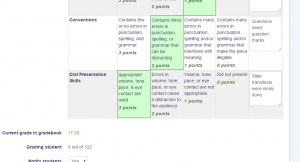Using rubrics to give feedback on iLearn (Moodle)
![]() One of my favorite features of iLearn (Moodle) is the ability to use rubrics for grading pretty much any type of assignment. Once an assignment is created, teachers can create a rubric of their own or adopt one of the several already-published rubrics available. They can even edit a published rubric to their liking. Once the rubric is prepared, grading student work using the rubric is as easy as clicking the appropriate description on the screen. This can even be done with a tablet, which makes grading a few taps of the screen.
One of my favorite features of iLearn (Moodle) is the ability to use rubrics for grading pretty much any type of assignment. Once an assignment is created, teachers can create a rubric of their own or adopt one of the several already-published rubrics available. They can even edit a published rubric to their liking. Once the rubric is prepared, grading student work using the rubric is as easy as clicking the appropriate description on the screen. This can even be done with a tablet, which makes grading a few taps of the screen.
T wo teachers who have mastered the use of rubrics this year are English Language Arts co-teachers Nicole West and Marla Wiacek at Stout Middle School. They have successfully used rubrics on iLearn to assess student work such as essays and presentations. Recently, students in their classes delivered an Historical Event Presentation, for which students were graded and given feedback using a Moodle rubric.
wo teachers who have mastered the use of rubrics this year are English Language Arts co-teachers Nicole West and Marla Wiacek at Stout Middle School. They have successfully used rubrics on iLearn to assess student work such as essays and presentations. Recently, students in their classes delivered an Historical Event Presentation, for which students were graded and given feedback using a Moodle rubric.
While students gave their presentations, Ms. West and Mrs. Wiacek matched the students’ work with the descriptions on their prepared rubric, hit “Save”, and iLearn did the rest: tallied up the scores and produced a final grade, which can then be exported into MiStar. This also comes with the added benefit that students receive an email and can view their feedback immediately after the assignment is graded. Moreover, students are able to see which teacher provided the feedback so they can contact them directly if they have questions.
In addition, teachers using rubrics have the option of offering more specific feedback within each criterion to better help students improve.
Moodle rubrics can be used for a variety of assignments, including (as stated above) presentations, essays submitted online, assignments submitted on paper, projects, performances, etc.

